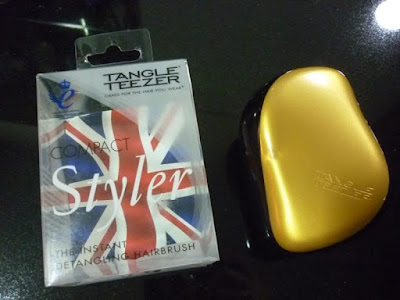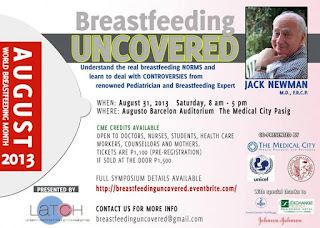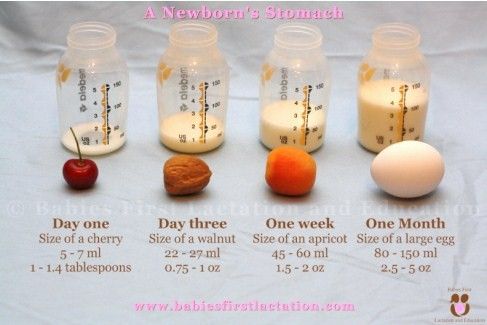By
Jazer Basan |
16 August 2013
Article is featured here. [Note: I was able to contribute for #5!]
Out with your baby and you need to nurse? Head on to these breastfeeding-friendly locations.
In March 2010, the Expanded
Breastfeeding Promotion Act of 2009 was signed into a law. Also known as
Republic Act 10028, it required all establishments or institutions to
have lactation stations, or nursing stations, which would provide
privacy to mothers who need to feed their babies while they’re out.
Since then, nursing stations have been set up in malls, airports, and
workplaces in compliance to this requirement. At present, however,
supermarkets, restaurants, bus stations and other public facilities are
yet to catch up with this ordinance.
Republic Act 10028 requires
lactation stations to be equipped with a sink for hand washing, a
cooling facility such as a refrigerator to store expressed milk,
electrical outlets for breast pumps, a small table, and comfortable
seats. Many breastfeeding stations in malls even went beyond these
requirements to make breastfeeding comfortable and relaxing for moms.
Let's take a look at some of the breastfeeding stations around Metro
Manila, and what moms have to say about them.
1. SM MegamallLocation: Lower ground floor of Building A (near the food court and exit to Bank Drive). Its entrance is through the mall's clinic.
Facilities: a sofa, side tables, and a changing table.
Note: SM Megamall is the first mall in the country to put up a breastfeeding station in 2006.
"Their
lounge has been useful to me because we frequent this mall. Their seats
are comfortable and amenities are okay. Having it beside the clinic is
an advantage in case I need medical assistance for myself or my baby."
-
Ludy Adrao, Senior Accounting Analyst, mom to Lyka, 9 years old and John Louie, 3 years old
2. SM Mall Of Asia
Location: Inside the mall clinic, at the far end of the 2nd floor on the Southside, Entertainment Mall, fronting Cosmic Kids.
Facilities: a sink, changing table, electrical outlets, and cushioned seats.
"Their nursing station is clean and well-equipped."
-
Mercy Yu-Lim
3. SM CubaoLocation: Inside the Department Store, near Cashier 21 and Baby Co.
Facilities: cushioned seats with armrests, sink, electrical outlets
4. SM North EDSA
Location: Lower ground floor of City Center, near the food court.
Facilities: cushioned seats with armrests, sink, electrical outlet.
5. SM Centerpoint Sta. MesaLocation: Ground floor inside the clinic, near SM Appliance Center
Facilities: electrical outlet, changing table, 1-seater sofas, easy access to the restroom
Note: Only mother and baby are allowed inside for the duration of the feeding.
6. Greenbelt 5 Family LoungeGreenbelt 5’s Family Lounge was styled by renowned Filipino designer Ito Kish
Location: 4th floor, Greenbelt 5.
Facilities: Private area for breastfeeding, nursing chair with footstool
Lounge Amenities: kids’ play area, tree design bookshelf, a business lounge, computer area with wifi, and restroom with changing table.
Note: Use of the family lounge requires an Amore or VIPinoy card but the use of the nursing area is free.
"I
find the couch and lighting sufficient. The curtain provides privacy to nursing mothers but lounge users could mistake the nursing area as another washroom. There's also an electrical outlet for pumps."
-
Cheryl Chan-Wong, 35, stay-at-home mom, Mandaluyong City
7. Glorietta Family LoungeLocation: Glorietta 4, 3rd floor near the Food Court
Facilities:
2 private nursing cubicles, each with an electrical outlet, cushioned single arm chair, cushioned stool. The restroom is adjacent to the
Nursing Room. There is a changing table in the restroom. The lounge has a
play area for kids and a mobile phone charging area.
Note: Nursing are free to use the nursing station. The lounge can be used for free by VIPinoy & Amore cardholders.
8. Trinoma
Trinoma boasts of a spacious breastfeeding room with space for strollers. With dim, relaxing light and cool ventilation, it calms both
Mommy and baby for that bonding moment.
Location: Level 3 beside Sony Square
Facilities: sink, changing table, electric outlet, private cubicles
Lounge Amenities: kids’ play area, wifi, lounge, TV, charging station, restrooms
Note: Use of the family lounge requires an Amore or VIPinoy card but the use of the nursing area is free.
"The
only thing I was expecting to see in a breastfeeding station is a
couch, sink or refrigerator. When we got to the lounge, I was really
surprised because it was way, way, way, way beyond my expectations."
-
Eva Gozon, nurse and work-at-home mommy to Carlos
9. Market Market
Location: 2nd floor, inside the family lounge.
Facilities: cozy interiors, cushioned seats with armrests, side table with lampshade, changing table, sink
Note: Free use for nursing mothers. The lounge is for the exclusive use of Amore and VIPinoy cardholders.
10. Robinson's Galleria
Location: 3rd floor, East Wing, near Mothercare
Facilities: sofa, changing table, sink
"I
actually don't need to use breastfeeding rooms because I use a nursing cover but I did check out the one at Robinson's Galleria. The hallway leading up to it was cheery and bright. The basics are there -- couch,
sink, and changing table. It was okay but a bit cramped. "
-
Bessie Colet Campillo, Enterpreneur/Owner of Nursingmom shop , mom to Amara and Adriana
11. Robinson's Place ManilaLocation: 3rd floor of Pedro Gil Wing, near the Security Office and David's Salon.
Facilities: 2-seater couch with an elevated center partition that can be used as a changing table.
12. Rustan's Shangri-la Mall EDSA
Location: 2nd floor, infants' section
Facilities: Pretty interiors, 4 armchairs, changing table, high chair, side table
"The
best breastfeeding station for me would be at Rustans Shangri-la. The
walls are designed with cute fairy decors, it has a clean and sturdy
changing table, comfy seats with pllows, cushioned flooring and bean
bags for kids. Use of this nursing station is free."
-
Raquel Chua, 33, full time mommy to Saffron 2 y/o.
13. Rustan's Makati
Location: 3rd floor infants' section.
Facilities: cozy interiors, couches, crib that can be used as changing table, side tables and a few toys.
"It
looks very new. There are cute stickers on the wall. I loved that they
really took time to design it. There was a changing table, the couches
were really comfortable with lots of pillows."
-
Ginger Palma Arboleda, 32 from Taguig, mompreneur and blogger
14. Rustan's Alabang Town Center
Location: 1st floor, infants’ section
Facilities: couch, changing tables, toys, electric outlet, easy access to restroom.
"The
Rustans breastfeeding station in ATC is spacious and comfortable. They
don't have a sink inside the room but bathroom is just a few meters
away."
-
Ysabelle Lorenzo
15. Shangri-la Plaza, EDSA
Location: Level 2, near Crossings Ramp and Planet Sports
Facilities: cushioned
chairs with arm rests and pillows, refrigerator, water heater,
microvawe oven, hand dryer, changing tables, electrical outlets
"Among
the nursing stations that I have been to, Shangri-la Plaza Mall is the
best. It is complete with amenities for moms who pump and feed directly.
Now that I have switched to cloth diapers full-time, having a wash
basin nearby is very helpful which Shangri-la has also kindly provided.
In the many times that I have been there, there is always someone who is
ready to assist, even just to open the door for you. And the place is
always kept clean. It is also beside a ladies' toilet if you need to use
one. "
-
Smiley Bernardo, 31, QC, full-time mommy to Caitlin, 2, and Olivia, 1.
16. Eastwood
Location: 3rd floor, between Babyland and Toys R Us.
Facilities: sink, changing table, cushioned seats with curtain partitions. There are also visuals on proper breastfeeding, and magazines
"Eastwood
is one of my favorite malls because of its nursing station. They have 2
curtain-covered stalls and cozy chairs with pillows, unlike others that
are open. In my experience, when my baby sees other babies in the room,
she gets distracted and wants to play with them instead. "
-
Jennifer Baradas-Bringas, mom to Dagny
17. Lucky China Town
Location: 3rd floor, near the pay bathroom, between My Phone and Cherry Mobile.
Facilities: plenty of seats, sink, side table, changing table and TV.
18. Mothercare Bonifacio High Street
Location: In-store, Bonifacio High Street Taguig
Facilities: sofa, sink, changing table, reading materials
"I
love the double stations, the safety bars and the big mirror! My little
one likes looking at his reflection while I change his diaper. The
friendly staff are also always ready to assist."
-
Jelyn Parian-Panol, mom to Ethan
19. NAIA Terminal 1
Location: Departure gate after final X-ray, near gate 16
Facilities:
electrical outlet, changing table, private cubicles with doors, hot and
cold water, long sofa, tissue dispenser and hand sanitizer
Note: Open 24 hours for departing and arriving passengers.
"What’s
great about the NAIA feeding station? It’s airconditioned, with 4
cubicles, cots and comfortable chairs. It comes with amenities like hand
sanitizers, a water dispenser, bottle warmer and first-aid supplies,
and is located right across Duty Free."
-
Jenny Ong, mom and breastfeeding advocate behind Chronicles of a Nursing Mom
Sources:Breastfeeding Pinayshttp://www.gov.ph/2010/03/16/republic-act-no-10028/http://www.unicef.org/philippines/mediacentre_9539.htmlhttp://125.60.203.88/miaa/http://www.chroniclesofanursingmom.com/http://www.everydaymommydiary.com/http://gojackiego.com/http://kish.ph/https://www.facebook.com/nursingmomhttp://lhenglang.blogspot.com/2009/08/breastfeeding-station.htmlPhoto credits (used with permission):Jenny Ong for album accessJackie Go - GloriettaIto Kish - Greenbelt 5Bessie Colet Campillo of Nursing Mom - Robinson's Galleria Eva Gozon and Precious Quintos - TrinomaGermaine Angeles - Robinsons ErmitaJennifer Baradas-Bringas - SM Cubao photosMichelle Esteban - NAIA photosJelyn Parian-Panol - MothercareMegaworld Malls Marketing Communications Team - Eastwood and Lucky ChinatownRustans Commercial Corporation - Marketing Communications DepartmentShangri-la Plaza Marketing Communications Department
Thumbnail image from babies411.com






































